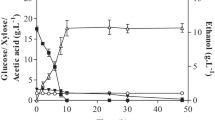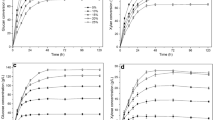Abstract
Sago pith residues (58 % starch, 23 % cellulose, 9.2 % hemicellulose, and 4 % lignin) are one of the abundant lignocellulosic residues generated after starch extraction process in sago mill. In this study, fermentable sugars from enzymatic hydrolysis of sago pith residues were converted to acetone–butanol–ethanol (ABE) by Clostridium acetobutylicum ATCC 824. With an initial concentration of 30 g/L of concentrated sago pith residues hydrolysate containing 23 g/L of glucose and 4.58 g/L of cellobiose, 4.22 ± 0.17 g/L of ABE were produced after 72 h of fermentation with yield and productivity of 0.20 g/g glucose and 0.06 g/L/h, respectively. Results are in agreement when synthetic glucose was used as a carbon source. Increasing sago pith residue hydrolysate to 50 g/L (containing 40 g/L glucose) and supplementing with 0.5 g/L yeast extract, approximately 8.84 ± 0.20 g/L of ABE (5.41 ± 0.10 g/L of butanol) were produced with productivity and yield of 0.12 g/L/h and 0.30 g/g glucose respectively, providing a 52 % improvement.
Similar content being viewed by others
Abbreviations
- ABE:
-
Acetone–butanol–ethanol
- DNS:
-
Dinitrosalicylic acid
- FID:
-
Flame ionization detector
- HMF:
-
Hydroxymethyl furfural
- HPLC:
-
High-performance liquid chromatography
- OPEFB:
-
Oil palm empty fruit bunch
- RCM:
-
Reinforced Clostridial Medium
References
Abd-Aziz S (2002) Sago starch and its utilization. J Biosci Bioeng 9(6):525–529
Abd-Alla MH, El-Enany AWE (2012) Production of acetone–butanol–ethanol from spoilage date palm (Phoenix dactylifera L.) fruits by mixed culture of Clostridium acetobutylicum and Bacillus subtilis. Biomass Bioenerg 42:172–178
Al-Shorgani NKN, Ali E, Kalil MS, Yusoff WMW (2011) The effect of different carbon sources on biobutanol production using Clostridium saccharoperbutylacetonicum N1-4. Biotechnol 10(3):280–285
Apun K, Salleh MA, Jong BC (2000) Screening and isolation of a cellulolytic and amylolytic Bacillus from sago pith waste. J Gen Appl Microbiol 46:263–267
Berezina OV, Brandt A, Yarotsky S, Schwarz WH, Zverlov VV (2009) Isolation of a new butanol-producing Clostridium strain: high level of hemicellulosic activity and structure of solventogenesis genes of a new Clostridium saccharobutylicum isolate. Syst Appl Microbiol 32:449–459
Bujang KB, Ahmad FB (2000) Country report of Malaysia: production and utilization of sago starch in Malaysia. The International Sago Seminar, Bogor, Indonesia, pp 1–8
Bujang KB, Apun K, Salleh MA (1996) A study in the production and bioconversion of sago waste. In Proceedings of the Sixth International Sago Symposium on Sago: the future source of food and feed. 9–12 Dec 1996, Universitas Riau, Pekanbaru, Sumatra, Republic of Indonesia
Bujang KB, Yusop MA, Ang SY (2004) Effects of aeration and agitation in the systematic treatment of sago effluent. The 26th Symposium of the Malaysian Society for Microbiology. Langkawi, Kedah, p 62
Ezeji T, Milne C, Price ND, Blaschek HP (2010) Achievements and perspectives to overcome the poor solvent resistance in acetone and butanol-producing microorganisms. Appl Microbiol Biotechnol 85:1697–1712
Fond O, Matta-Ammouri G, Petitdemange H, Engasser JM (1985) The role of acids on the production of acetone and butanol by Clostridium acetobutylicum. Appl Microbiol Biotechnol 22:195–200
Geng Q, Park C (1993) Controlled-pH batch butanol–acetone fermentation by low acid producing Clostridium acetobutylicum B18. Biotechnol Lett 15:421–426
Haska N (2002) The utilization of the fibrous residue of sago palm as a substrate for the cultivation of edible mushrooms. In: Kainuma K, Okazaki M, Toyoda Y, Cecil JE (eds) Proceedings of the International Symposium on Sago: New Frontiers of Sago Palm Studies. Universal Academy Press, Tokyo, pp 133–140
Ibrahim MF, Abd-Aziz S, Razak MNA, Phang LY, Hassan MA (2012) Oil palm empty fruit bunch as alternative substrate for acetone–butanol–ethanol production by Clostridium butyricum EB6. Appl Biochem Biotechnol 166:1615–1625
Kumar N, Das D (2000) Enhancement of hydrogen production by Enterobacter cloaca IIT-BT 08. Process Biochem 35:589–593
Kumaran S, Sastry CA, Vikineswary S (1997) Laccase, cellulose and xylanase activities during growth of Pleurotus sajor-caju on sago hampas. World J Microbiol Biotechnol 13(1):43–49
Kumoro AC, Ngoh GC, Hasan M, Ong CH, Teoh EC (2008) Conversion of fibrous sago (Metroxylon sagu) waste into fermentable sugar via acid and enzymatic hydrolysis. Asian J Sci Res 1:412–420
Lee SY, Park JH, Jang SH, Nielsen LK, Kim J, Jung KS (2008) Fermentative butanol production by Clostridia. Biotechnol Bioeng 101:209–228
Lee J, Seo E, Kweon DH, Park K, Jin YS (2009) Fermentation of rice bran and defatted rice bran for butanol production using Clostridium beijerinckii NCIMB 8052. J Microbiol Biotechnol 19:482–490
Liu Z, Ying Y, Li F, Ma C, Xu P (2010) Butanol production by Clostridium beijerinckii ATCC 55025 from wheat bran. J Ind Microbiol Biotechnol 37:495–501
Maddox IS, Steiner E, Hirsch S, Wessner S, Gutierrez NA, Gapes JR et al (2000) The cause of “acid crash” and “acidogenic fermentations” during the batch acetone–butanol–ethanol (ABE) fermentation process. J Mol Microbiol Biotechnol 2(1):95–100
Madihah MS, Ariff AB, Sahaid KM, Suraini AA, Karim MIA (2001) Direct fermentation of gelatinized sago starch to acetone–butanol–ethanol by Clostridium acetobutylicum. World J Microbiol Biotechnol 17:567–576
Mansfield SD, Meder R (2003) Cellulose hydrolysis—the role of monocomponent cellulases in crystalline cellulose degradation. Cellulose 10:159–169
Miller GL (1959) Use of DNS reagent for the determination of reducing sugars. Anal Chem 31:426–428
Monot F, Martin JR, Petitdemange H, Gay R (1982) Acetone and butanol production by Clostridium acetobutylicum in a synthetic medium. Appl Environ Microbiol 44(6):1318–1324
Monot F, Engasser JM, Petitdemange H (1984) Influence of pH and undissocited butyric acid on production of acetone and butanol in batch cultures of C. acetobutylicum. Appl Microbiol Biotechnol 19:422–426
Ozawa T, Takahiro O, Osama N (1996) Hemicelluloses in the fibrous residue of sago palm. Proceeding of Sixth International Sago Symposium, Pekan Baru
Palonen H (2004) Role of lignin in the enzymatic hydrolysis of lignocelluloses. VTT Technol VTT Publi 520:1–42
Qureshi N, Blaschek HP (1999) Butanol recovery from model solutions/fermentation broth by pervaporation: evaluation of membrane performance. Biomass Bioenerg 17:175–184
Qureshi N, Blaschek HP (2000) Economics of butanol fermentation using hyper-butanol producing Clostridium beijerinckii BA101. Food Bioprod Process 78:139–144
Qureshi N, Ebener J, Ezeji TC, Dien B, Cotta MA, Blaschek HP (2008) Butanol production by Clostridium beijerinckii BA101. Part I: use of acid and enzyme hydrolysed corn fiber. Bioresour Technol 99:5915–5922
Qureshi N, Saha BC, Hector RE, Cotta MA (2008) Removal of fermentation inhibitors from alkaline peroxide pretreated and enzymatically hydrolyzed wheat straw: production of butanol from hydrolysate using Clostridiun beijierinckii in batch reactors. Biomass Bioenerg 32:1353–1358
Qureshi N, Saha BC, Hector RE, Dien B, Hughes S, Liu S et al (2010) Production of butanol (a biofuel) from agricultural residues: part II—use of corn stover and switchgrass hydrolysates. Biomass Bioenerg 34(4):566–571
Sun Z, Liu S (2010) Production of n-butanol from concentrated sugar maple hemicellulosic hydrolysate by Clostridia acetobutylicum ATCC824. Biomass Bioenerg 39:39–47
Ugam J (2011) Pretreatment of sago fibre for maximum fermentable sugars production. Master thesis. Universiti Malaysia Sarawak.
Vikineswary S, Abdullah N, Renuvathani M, Sekaran M, Pandey A, Jones EBG (2005) Productivity of laccase in solid substrate fermentation of selected agro-residues by Pycnoporus sanguineus. J Bioresour Technol 97:171–177
Wang L, Chen H (2011) Increased fermentability of enzymatically hydrolyzed steam-exploded corn stover for butanol production by removal of fermentation inhibitors. Process Biochem 46:604–607
Acknowledgments
The authors would like to thank Universiti Putra Malaysia for financial support throughout this research project.
Author information
Authors and Affiliations
Corresponding author
Rights and permissions
About this article
Cite this article
Linggang, S., Phang, L.Y., Wasoh, H. et al. Acetone–Butanol–Ethanol Production by Clostridium acetobutylicum ATCC 824 Using Sago Pith Residues Hydrolysate. Bioenerg. Res. 6, 321–328 (2013). https://doi.org/10.1007/s12155-012-9260-9
Published:
Issue Date:
DOI: https://doi.org/10.1007/s12155-012-9260-9




